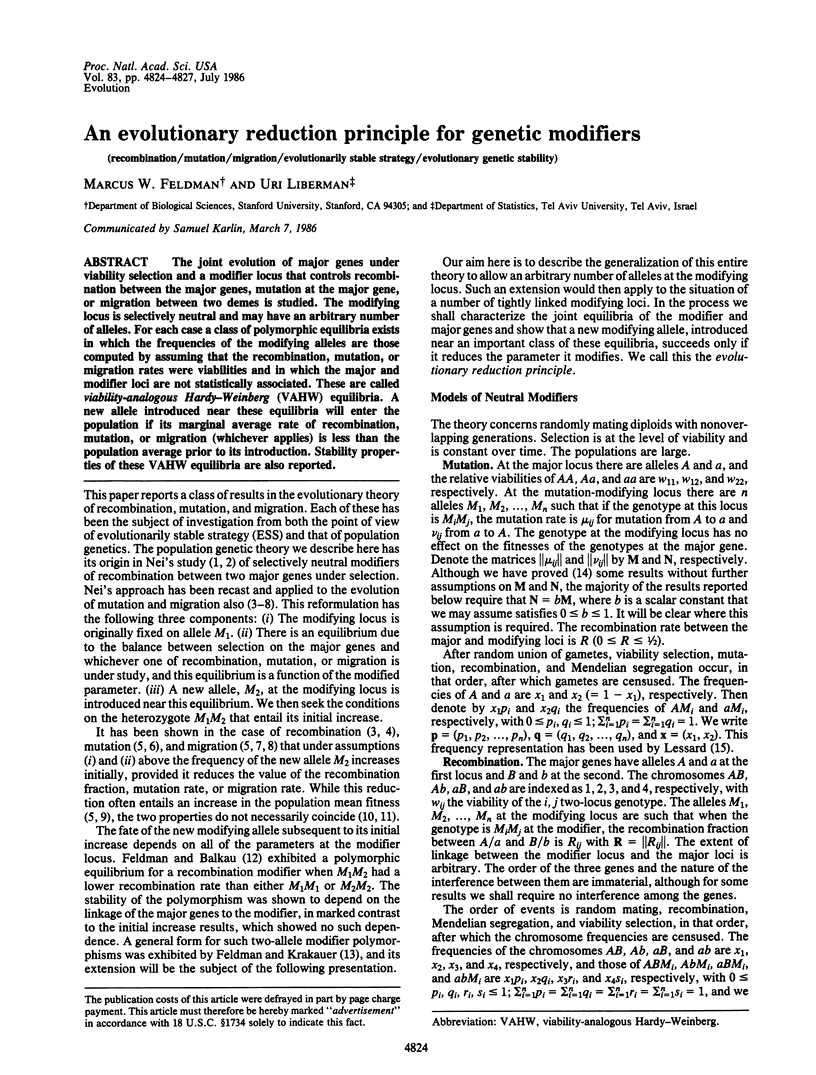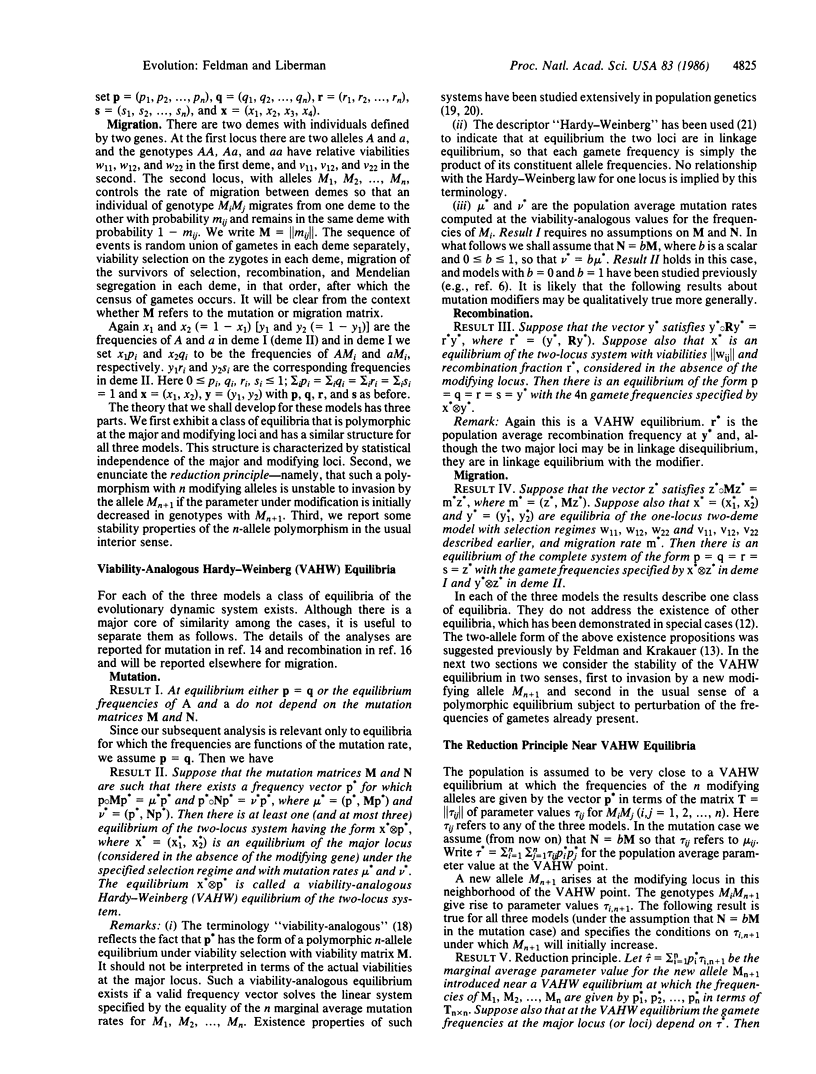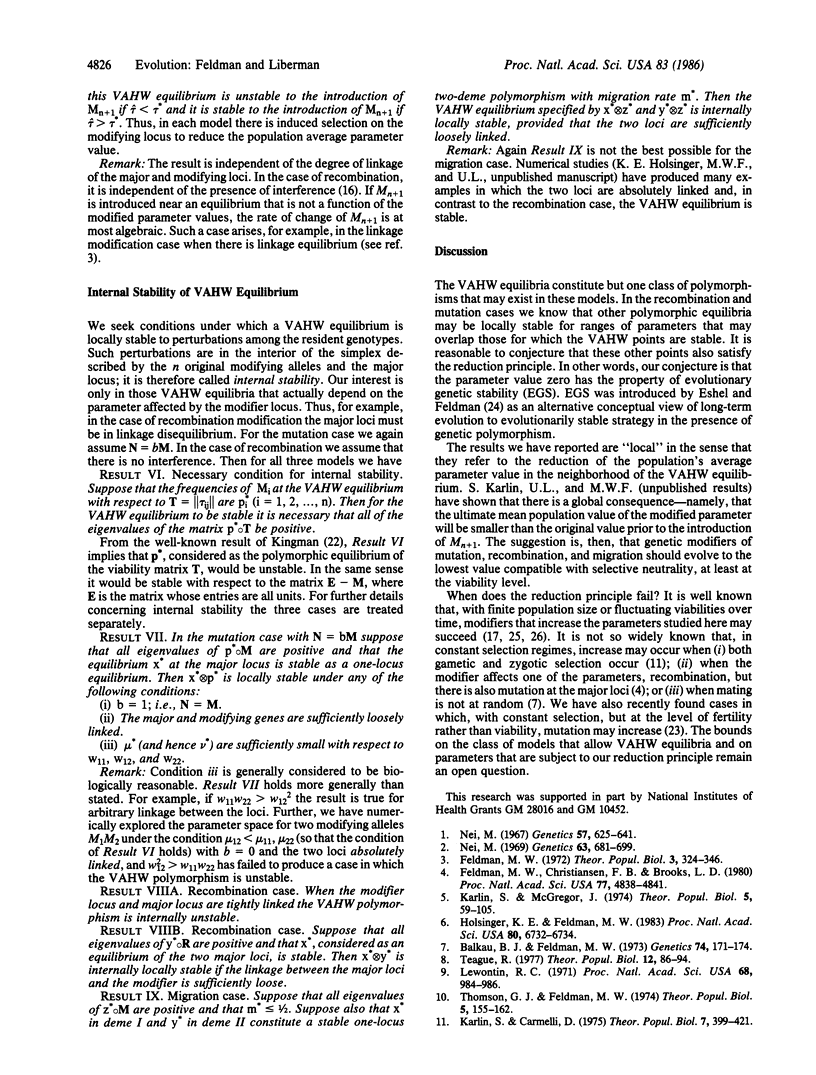Abstract
The joint evolution of major genes under viability selection and a modifier locus that controls recombination between the major genes, mutation at the major gene, or migration between two demes is studied. The modifying locus is selectively neutral and may have an arbitrary number of alleles. For each case a class of polymorphic equilibria exists in which the frequencies of the modifying alleles are those computed by assuming that the recombination, mutation, or migration rates were viabilities and in which the major and modifier loci are not statistically associated. These are called viability-analogous Hardy-Weinberg (VAHW) equilibria. A new allele introduced near these equilibria will enter the population if its marginal average rate of recombination, mutation, or migration (whichever applies) is less than the population average prior to its introduction. Stability properties of these VAHW equilibria are also reported.
Full text
PDF



Selected References
These references are in PubMed. This may not be the complete list of references from this article.
- Balkau B. J., Feldman M. W. Selection for migration modification. Genetics. 1973 May;74(1):171–174. doi: 10.1093/genetics/74.1.171. [DOI] [PMC free article] [PubMed] [Google Scholar]
- Charlesworth B. Recombination modification in a flucturating environment. Genetics. 1976 May;83(1):181–195. doi: 10.1093/genetics/83.1.181. [DOI] [PMC free article] [PubMed] [Google Scholar]
- Feldman M. W., Balkau B. Selection for Linkage Modification II. a Recombination Balance for Neutral Modifiers. Genetics. 1973 Aug;74(4):713–726. doi: 10.1093/genetics/74.4.713. [DOI] [PMC free article] [PubMed] [Google Scholar]
- Feldman M. W., Christiansen F. B., Brooks L. D. Evolution of recombination in a constant environment. Proc Natl Acad Sci U S A. 1980 Aug;77(8):4838–4841. doi: 10.1073/pnas.77.8.4838. [DOI] [PMC free article] [PubMed] [Google Scholar]
- Feldman M. W. Selection for linkage modification. I. Random mating populations. Theor Popul Biol. 1972 Sep;3(3):324–346. doi: 10.1016/0040-5809(72)90007-x. [DOI] [PubMed] [Google Scholar]
- Gillespie J. H. Evolution of the mutation rate at a heterotic locus. Proc Natl Acad Sci U S A. 1981 Apr;78(4):2452–2454. doi: 10.1073/pnas.78.4.2452. [DOI] [PMC free article] [PubMed] [Google Scholar]
- Holsinger K. E., Feldman M. W. Modifiers of mutation rate: Evolutionary optimum with complete selfing. Proc Natl Acad Sci U S A. 1983 Nov;80(21):6732–6734. doi: 10.1073/pnas.80.21.6732. [DOI] [PMC free article] [PubMed] [Google Scholar]
- Karlin S., Carmelli D. Numerical studies on two-loci selection models with general viabilities. Theor Popul Biol. 1975 Jun;7(3):399–421. doi: 10.1016/0040-5809(75)90026-x. [DOI] [PubMed] [Google Scholar]
- Karlin S., Liberman U. Central equilibria in multilocus systems. I. Generalized nonepistatic selection regimes. Genetics. 1979 Apr;91(4):777–798. doi: 10.1093/genetics/91.4.777. [DOI] [PMC free article] [PubMed] [Google Scholar]
- Karlin S., McGregor J. Towards a theory of the evolution of modifier genes. Theor Popul Biol. 1974 Feb;5(1):59–103. doi: 10.1016/0040-5809(74)90052-5. [DOI] [PubMed] [Google Scholar]
- Karlin S. Some natural viability systems for a multiallelic locus: a theoretical study. Genetics. 1981 Feb;97(2):457–473. doi: 10.1093/genetics/97.2.457. [DOI] [PMC free article] [PubMed] [Google Scholar]
- Lewontin R. C., Ginzburg L. R., Tuljapurkar S. D. Heterosis as an explanation for large amounts of genic polymorphism. Genetics. 1978 Jan;88(1):149–169. doi: 10.1093/genetics/88.1.149. [DOI] [PMC free article] [PubMed] [Google Scholar]
- Lewontin R. C. The effect of genetic linkage on the mean fitness of a population. Proc Natl Acad Sci U S A. 1971 May;68(5):984–986. doi: 10.1073/pnas.68.5.984. [DOI] [PMC free article] [PubMed] [Google Scholar]
- Nei M. Linkage modifications and sex difference in recombination. Genetics. 1969 Nov;63(3):681–699. doi: 10.1093/genetics/63.3.681. [DOI] [PMC free article] [PubMed] [Google Scholar]
- Nei M. Modification of linkage intensity by natural selection. Genetics. 1967 Nov;57(3):625–641. doi: 10.1093/genetics/57.3.625. [DOI] [PMC free article] [PubMed] [Google Scholar]
- Teague R. A model of migration modification. Theor Popul Biol. 1977 Aug;12(1):86–94. doi: 10.1016/0040-5809(77)90036-3. [DOI] [PubMed] [Google Scholar]
- Thomson G. J., Feldman M. W. Population genetics of modifiers of meiotic drive. II. Linkage modification in the segregation distortion system. Theor Popul Biol. 1974 Apr;5(2):155–162. doi: 10.1016/0040-5809(74)90038-0. [DOI] [PubMed] [Google Scholar]


